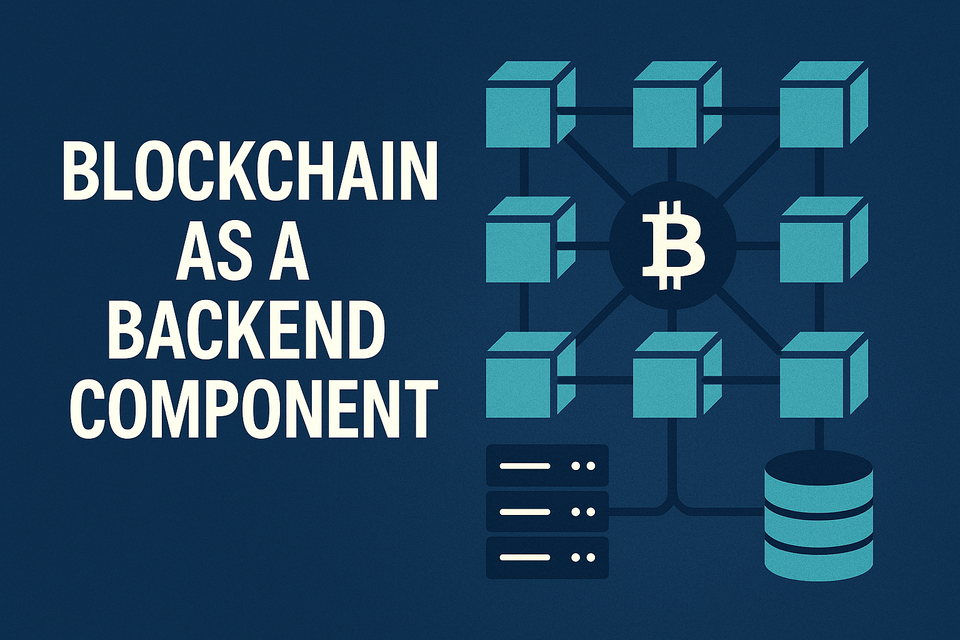Blockchain as a Backend Component

A component in the back-end, not the entire back-end, not even the core back-end. This approach to DApp system design opens up the range of applications in which blockchain can be employed. Developers have the flexibility to sprinkle blockchain across their applications.
Oftentimes, blockchain developers try to do everything on the blockchain, and I've been a culprit myself. After being in production a couple of times with user-facing projects, I have concluded that every technology has unique properties that contribute to the system design of a project. Blockchain has unique properties that no other technology has. Just like redis is usually the go-to for a fast in-memory data structure store. Blockchain is a great component for back-end systems that require
- Decentralization
- Immutability
- Censorship Resistance
- Transparency / Privacy
At first, this might seem like a limiting idea about blockchain adoption, but it would lead to mass usage by system engineers. Databases are used everywhere because they do one thing very well. They do not seek to be the entire backend; engineers love them because they give flexibility to integrate with many other tools.
Real World Examples
Let's explore some real-world web2 applications that could be improved by using blockchain in specific parts of the application. The day-to-day user might not know that parts of the backend utilize blockchain, and they might not need to know. Blockchain-savvy users may know and, as such, might use it to satisfy certain requirements of theirs.
Payment Escrow Service
These are applications that allow two strangers to transact trustlessly on the internet. Suppose you are scrolling social media and find products from a shop you want to purchase. Most of these platforms don't have payment directly integrated, and so it is the responsibility of the buyer and seller to decide how to transact. A payment escrow can allow the buyer to deposit the money and only release it once they have received the product.
Without this, they would have to send money to the seller and trust to would receive the product; many people have been duped this way. Escrow.com is an example of such a product that provide online escrow services amongst others. They can improve their system by including blockchain in strategic aspects of their system design.
Blockchain doesn’t need to hold the money, it just needs to provide an immutable ledger of what’s going on. That way, even if the company database is compromised, the escrow data is tamper-proof and recoverable. This is a desirable property that would make us all architects have a good night's sleep.
P2P E-Commerce with Payment Escrow Service
P2P e-commerce services allow sellers to list their products and connect them directly to buyers. The platform only provides tools to connect; beyond that, it is up to the buyer and seller to determine how to further transact.
Platforms like Scrowton.com take it to the next level by including blockchain-based escrow services to safeguard transactions for both buyers and sellers using smart contracts on Stellar.
For delivery, the platform integrates several third-party delivery services on the condition that they post delivery updates to the blockchain. This allows the platform to keep track of the delivery without having to handle logistics. Just by providing a portable SDK that connects to the central smart contract they can make several guarantees for the safety of the users.
P2P Stablecoin and Crypto Exchange Platform
P2P exchange remains one of the major ways crypto is bought and sold. Most of the prominent P2P exchanges have been centralized till now. One of the decentralized P2P exchanges is IExchange.
With this approach, transactions involving token transfers are conducted directly on the blockchain. This allows you to easily connect your wallet and start trading. That is the only part that needs to be on-chain. Other aspects, such as merchants listing their offers, adding payment methods, and details, do not need to be on the blockchain. This approach simplifies system design by utilizing each component according to its purpose and strengths.
Conclusion
We don’t need to put everything on-chain to use blockchain effectively. Instead, let’s integrate it where it delivers real value, security, trustlessness, decentralization, and leave the rest to battle-tested web infrastructure.
This approach will lead to more robust, user-friendly apps that harness blockchain’s superpowers without overcomplicating the system.